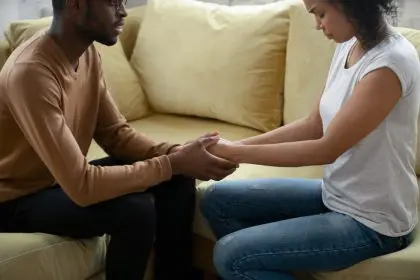We’ve all been there – sitting across from someone we like, carefully filtering our words, making sure we present our most polished, impressive selves. We hide our struggles, minimize our failures, and showcase our highlights. And then we wonder why our friendships feel shallow and unsatisfying.
What if the very thing we’re trying to hide – our authentic, messy, imperfect selves – is exactly what creates the deep connections we crave? It sounds counterintuitive, but vulnerability might be the most powerful social skill you’re not using enough.
The vulnerability paradox explained
Here’s the strange contradiction most of us live with – we’re drawn to vulnerability in others but terrified to show it ourselves. When a friend opens up about their insecurities, shares a painful experience, or admits a struggle, we don’t think less of them. Usually, we feel closer to them, honored by their trust, and more connected than before.
Yet when we consider sharing our own struggles, we imagine the worst. We picture judgment, rejection, or using our revealed weaknesses against us. This mental disconnect – appreciating vulnerability in others while fearing it in ourselves – keeps many of us trapped in superficial relationships.
The truth is, most people respond to vulnerability the same way you do – with increased closeness, not judgment. What feels risky to share is often exactly what makes someone think, “Wow, they trust me” or “I’m not the only one who feels this way.”
The false armor of perfectionism
Many of us grew up believing that showing weakness makes us less likable or respectable. We learned to present a curated version of ourselves – competent, confident, and in control. We thought this perfect image would draw people to us.
But perfectionism creates distance, not closeness. When you never share your struggles, you unknowingly build walls between yourself and others. The polished image might impress people from a distance, but it doesn’t let them get close enough to truly know and love you.
Think about your own experience with seemingly perfect people. They might trigger admiration, but do they inspire connection? That flawless colleague who never admits mistakes, that social media friend whose life looks immaculate – you might respect them, but do you feel close to them?
Real connection happens when people see behind the curtain to the authentic human underneath. The friend who admits they’re struggling with parenting, the colleague who acknowledges they’re nervous about a presentation – these moments of humanity create bridges between people.
The science of why vulnerability creates trust
When someone shares something personal, especially something that involves risk, it triggers a powerful psychological response. Your brain registers this disclosure as an act of trust, which naturally encourages you to trust them in return.
This reciprocal vulnerability creates a positive feedback loop. One person opens up, which makes the other person feel safe to share something personal too. Each exchange deepens the trust between you, gradually building a relationship foundation that can support authentic connection.
Researchers who study friendship formation have found that escalating levels of mutual disclosure is one of the most reliable ways to develop closeness. Simply spending time together isn’t enough – it’s the progressive sharing of your inner worlds that transforms acquaintances into friends.
This explains why some of your most meaningful friendships might have formed during challenging times. The college roommate you stayed up with during mutual crises, the coworker you vented with during a difficult project – these shared vulnerabilities fast-tracked your connection in ways that casual happy hour conversations never could.
The courage to go first changes everything
Most people wait for others to show vulnerability before they risk showing their own. They’re waiting for someone else to make the first move, to establish that it’s safe to be real. This cautious approach makes sense, but it also means many potential deep connections never materialize because everyone’s waiting for someone else to break the ice.
Being the person who’s willing to go first – to share a struggle, admit an insecurity, or ask for help – can transform your social landscape. It signals to others that you’re open to authentic connection and creates space for them to reciprocate.
This doesn’t mean oversharing with strangers or dumping your deepest traumas in casual conversation. Healthy vulnerability is contextual and gradual. It might start with admitting you’re nervous about something, sharing a minor struggle, or expressing an unpopular opinion you genuinely hold.
The willingness to be slightly more open than is comfortable can act as a magnet for deeper friendships. People who value authentic connection will respond in kind, while those who prefer to keep things surface-level naturally drift toward others who maintain similar boundaries.
The vulnerability sweet spot for friendship
Not all vulnerability creates connection. There’s a sweet spot between total guardedness and inappropriate oversharing that builds rather than damages relationships.
Healthy vulnerability involves sharing feelings, experiences, and parts of yourself that feel slightly risky but are genuinely relevant to the relationship or conversation. It’s not performative or manipulative, but authentic and offered without expectation.
For example, telling a newer friend that you sometimes struggle with self-doubt at work feels appropriately vulnerable. It’s relevant to getting to know each other, shows trust, and opens the door to deeper conversation. In contrast, sharing intimate details about a recent breakup might feel too intense too soon.
The sweet spot differs depending on the relationship context, your personality, and cultural factors. Some friendships naturally progress to deep vulnerability quickly, while others build more gradually. The key is pushing your comfort zone slightly rather than keeping all your walls firmly in place.
How defensiveness blocks friendship chemistry
Have you ever noticed how some people seem to make friends effortlessly? Often, these natural connectors aren’t necessarily more interesting or accomplished than others – they’re simply less defensive.
Defensiveness – the tendency to protect yourself from potential criticism or rejection – is kryptonite to deep friendship. It shows up as justifying your actions before anyone has criticized them, deflecting personal questions, changing the subject when things get too real, or using humor to avoid sincere moments.
These self-protective habits feel safe in the moment but ultimately prevent the vulnerability exchanges that build trust. They send subtle signals that you’re not available for authentic connection.
Reducing defensiveness doesn’t happen overnight. It starts with noticing when you’re putting up shields unnecessarily. Are you automatically explaining your reasoning when sharing a decision? Do you deflect compliments or turn serious questions into jokes? These moments are opportunities to practice staying open instead of armoring up.
The unexpected strength in admitting weakness
Perhaps the greatest irony about vulnerability is that what feels like weakness actually communicates strength. Admitting mistakes, sharing fears, or asking for help might feel like revealing inadequacy, but others often perceive these actions as signs of self-awareness and confidence.
Think about it – it takes significant inner security to say “I was wrong” or “I’m struggling with this” or “I don’t know how to do that.” People who can’t admit these things are usually perceived as insecure, not strong.
True confidence isn’t about appearing perfect – it’s about being comfortable enough with your imperfections to acknowledge them. When you demonstrate this kind of authentic confidence, you become magnetic to others who value depth over appearance.
This reframing helps make vulnerability feel less threatening. You’re not exposing weakness – you’re demonstrating the strength of self-awareness and authenticity. This perspective shift can make it easier to take the small risks that lead to deeper connections.
How vulnerability filters for compatible friends
Not everyone responds positively to vulnerability. Some people are uncomfortable with emotional depth, prefer to keep relationships light, or even take advantage of the openness of others. This can make vulnerability feel risky – what if you open up and get rejected or exploited?
However, vulnerability actually serves as an effective filtering mechanism for compatible friendships. When you share authentically and someone responds with judgment or discomfort, you’ve learned important information about your compatibility as friends.
Likewise, when you take a risk and someone responds with warmth, understanding, or reciprocal sharing, you’ve identified someone with whom deeper connection is possible. Without these vulnerability exchanges, you might spend years in superficial friendships with people who aren’t actually capable of the depth you desire.
This filtering function becomes increasingly valuable as you get older and have less time for casual socializing. Vulnerability accelerates the friendship-compatibility assessment, helping you invest in relationships with genuine potential.
Digital barriers to vulnerable connection
Modern friendship faces a unique challenge – the digital interfaces through which we increasingly communicate. Text messages, social media, and email strip away the nonverbal cues that make vulnerability feel safer in person.
When you can’t see someone’s empathetic expression or hear their supportive tone, sharing something personal feels riskier. The delayed response time of digital communication can amplify anxiety – that gap between sending a vulnerable message and receiving a reply can feel like an eternity of potential rejection.
Social media compounds the problem by encouraging highlight reels rather than authentic sharing. The metrics-driven environment rewards polished presentations over messy reality, training us to hide our struggles behind carefully filtered images.
Recognizing these digital barriers helps you make conscious choices about where and how to practice vulnerability. Perhaps some conversations need to happen face-to-face rather than via text. Maybe you need occasional digital detoxes to remember how to connect authentically. Or perhaps you can be intentional about bringing appropriate vulnerability to your online interactions, modeling a different way of engaging.
Small steps toward more authentic connection
Building vulnerability into your friendship approach doesn’t require dramatic confessions or immediate deep sharing. It starts with small moments of authentic presence that gradually expand your comfort zone and signal your openness to deeper connection.
It might begin with simply answering “How are you?” honestly instead of automatically saying “fine.” It could involve mentioning something you’re genuinely struggling with when a friend asks about your week. Or perhaps it means asking for help with something small instead of maintaining total self-sufficiency.
Each small act of authentic sharing creates an opening for connection. Some people won’t walk through that opening, and that’s valuable information. But others will respond in kind, beginning the exchange of vulnerability that builds truly satisfying friendships.
The most meaningful connections in your life likely began with someone being brave enough to be real. Sometimes that person was you, sometimes it was them – but that willingness to lower the perfect facade made everything else possible. Your future deep friendships are waiting on the other side of the same courage.


















